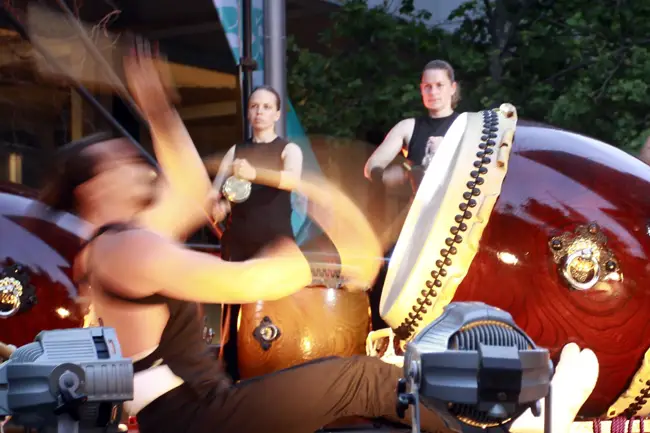
You’re welcome to send your Live Wire news tips or suggestions to [email protected].
Today’s Live Wire: Quick Links
- In Defense of Inflamed Rhetoric
- Tucson Shooter and Arizona Politics
- Newsflash: Internet Gains on TV
- Charles Barkley vs. Tucker Carlson
- Crazy Horse, Crazy Monument
- 9 Billion Souls and Counting
- On Joseph Brodsky
- Kafka-Inspired: Two Men
- A Few Good Links
![]()
Live Wire Rewinds
In Defense of Inflamed Rhetoric
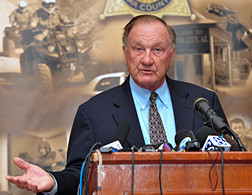 From Slate: “The lead spokesman for the anti-inflammatory movement […] was Pima County Sheriff Clarence Dupnik, whose jurisdiction includes Tucson. Said Dupnik at a Jan. 8 press conference in answer to questions about the criminal investigation:
From Slate: “The lead spokesman for the anti-inflammatory movement […] was Pima County Sheriff Clarence Dupnik, whose jurisdiction includes Tucson. Said Dupnik at a Jan. 8 press conference in answer to questions about the criminal investigation:
I’d just like to say that when you look at unbalanced people, how they are—how they respond to the vitriol that comes out of certain mouths, about tearing down the government, the anger, the hatred, the bigotry that goes on in this country is getting to be outrageous. And unfortunately, Arizona, I think, has become sort of the capital. We have become the mecca for prejudice and bigotry.
Embedded in Sheriff Dupnik’s ad hoc wisdom were several assumptions. First, that strident, anti-government political views can be easily categorized as vitriolic, bigoted, and prejudicial. Second, that those voicing strident political views are guilty of issuing Manchurian Candidate-style instructions to commit murder and mayhem to the “unbalanced.” Third, that the Tucson shooter was inspired to kill by political debate or by Sarah Palin’s “target” map or other inflammatory outbursts. Fourth, that we should calibrate our political speech in such a manner that we do not awaken the Manchurian candidates among us. And, fifth, that it’s a cop’s role to set the proper dimensions of our political debate. Hey, Dupnik, if you’ve got spare time on your hands, go write somebody a ticket. Sheriff Dupnik’s political sermon came before any conclusive or even circumstantial proof had been offered that the shooter had been incited by anything except the gas music from Jupiter playing inside his head. For as long as I’ve been alive, crosshairs and bull’s-eyes have been an accepted part of the graphical lexicon when it comes to political debates. Such “inflammatory” words as targeting, attacking, destroying, blasting, crushing, burying, knee-capping, and others have similarly guided political thought and action. Not once have the use of these images or words tempted me or anybody else I know to kill. I’ve listened to, read—and even written!—vicious attacks on government without reaching for my gun. I’ve even gotten angry, for goodness’ sake, without coming close to assassinating a politician or a judge. From what I can tell, I’m not an outlier. […] The great miracle of American politics is that although it can tend toward the cutthroat and thuggish, it is almost devoid of genuine violence outside of a few scuffles and busted lips now and again. With the exception of Saturday’s slaughter, I’d wager that in the last 30 years there have been more acts of physical violence in the stands at Philadelphia Eagles home games than in American politics. Any call to cool “inflammatory” speech is a call to police all speech, and I can’t think of anybody in government, politics, business, or the press that I would trust with that power.” The full piece.
See Also:
Tucson Shooter and Arizona Politics
 John Judis at The New Republic: “[I]f you look broadly at today’s political discourse […] what you find is that gun, warrior, murder, mayhem, and generally Armageddon-like, apocalyptic rhetoric is virtually monopolized by right-wing organizations, talk-show hosts, and politicians. That is not saying that the right always monopolizes the rhetoric of violence. Certainly it has in the South, but in different eras, the left rather than the right has had the franchise in the far west and the north. Think, for instance, of the late ‘60s. But in the last two years, there is no contest. […] Arizona’s preoccupation with illegal immigration, and its other right-wing enthusiasms, were tempered in the past by Arizona’s business leaders and by a group of Arizona Democrats and moderate Republicans, often led by McCain. In the late ‘80s, when Republican Governor Evan Meacham cancelled the state’s celebration of Martin Luther King Jr.’s birthday, the same group of politicians and business leaders intervened. And while she was governor, Democrat Janet Napolitano kept the right’s passions somewhat in check. But last year, the nuts gained control of the asylum, and McCain himself resigned his position as supervisor to join the inmates in yelling and screaming about big government, Mexification, and whatever other thing popped into their brains. McCain campaigned with Giffords’s opponent Kelly, who besides focusing on the immigrant threat, also wanted to get rid of Social Security and Medicare. Given the absence of adult supervision, Arizona has become a haven for the radical right.” The full piece.
John Judis at The New Republic: “[I]f you look broadly at today’s political discourse […] what you find is that gun, warrior, murder, mayhem, and generally Armageddon-like, apocalyptic rhetoric is virtually monopolized by right-wing organizations, talk-show hosts, and politicians. That is not saying that the right always monopolizes the rhetoric of violence. Certainly it has in the South, but in different eras, the left rather than the right has had the franchise in the far west and the north. Think, for instance, of the late ‘60s. But in the last two years, there is no contest. […] Arizona’s preoccupation with illegal immigration, and its other right-wing enthusiasms, were tempered in the past by Arizona’s business leaders and by a group of Arizona Democrats and moderate Republicans, often led by McCain. In the late ‘80s, when Republican Governor Evan Meacham cancelled the state’s celebration of Martin Luther King Jr.’s birthday, the same group of politicians and business leaders intervened. And while she was governor, Democrat Janet Napolitano kept the right’s passions somewhat in check. But last year, the nuts gained control of the asylum, and McCain himself resigned his position as supervisor to join the inmates in yelling and screaming about big government, Mexification, and whatever other thing popped into their brains. McCain campaigned with Giffords’s opponent Kelly, who besides focusing on the immigrant threat, also wanted to get rid of Social Security and Medicare. Given the absence of adult supervision, Arizona has become a haven for the radical right.” The full piece.
See Also:
- The Gabrielle Giffords Shooting – Irony and Coincidence, Integrity and Foreshadowing
- Your Papers Please: Arizona-Style Immigrant-Profiling Law Introduced in Florida
- Florida members of Congress vow to not let the Arizona shooting deter them
- Arizona Boots Up Brown Immigrants’ Guantanamo
- The Judge Behind the Decision Striking Down Parts of Arizona’s Anti-Immigration Law
Newsflash: Internet Gains on TV News
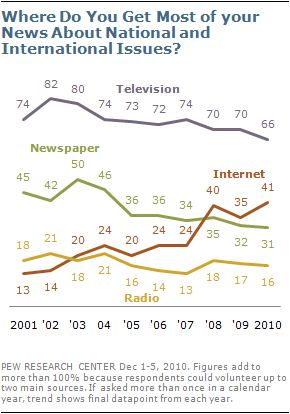 From Pew: “The internet is slowly closing in on television as Americans’ main source of national and international news. Currently, 41% say they get most of their news about national and international news from the internet, which is little changed over the past two years but up 17 points since 2007. Television remains the most widely used source for national and international news – 66% of Americans say it is their main source of news – but that is down from 74% three years ago and 82% as recently as 2002. […] more people continue to cite the internet than newspapers as their main source of news, reflecting both the growth of the internet, and the gradual decline in newspaper readership (from 34% in 2007 to 31% now). The proportion citing radio as their main source of national and international news has remained relatively stable in recent years; currently, 16% say it is their main source.
From Pew: “The internet is slowly closing in on television as Americans’ main source of national and international news. Currently, 41% say they get most of their news about national and international news from the internet, which is little changed over the past two years but up 17 points since 2007. Television remains the most widely used source for national and international news – 66% of Americans say it is their main source of news – but that is down from 74% three years ago and 82% as recently as 2002. […] more people continue to cite the internet than newspapers as their main source of news, reflecting both the growth of the internet, and the gradual decline in newspaper readership (from 34% in 2007 to 31% now). The proportion citing radio as their main source of national and international news has remained relatively stable in recent years; currently, 16% say it is their main source.
[…] An analysis of how different generations are getting their news suggests that these trends are likely to continue. In 2010, for the first time, the internet has surpassed television as the main source of national and international news for people younger than 30. Since 2007, the number of 18 to 29 year olds citing the internet as their main source has nearly doubled, from 34% to 65%. Over this period, the number of young people citing television as their main news source has dropped from 68% to 52%. Among those 30 to 49, the internet is on track to equal, or perhaps surpass, television as the main source of national and international news within the next few years. Currently, 48% say the internet is their main source – up 16 points from 2007 – and 63% cite television – down eight points. […] those with household incomes of $75,000 or more are about as likely to get most of their news on the internet (54%) as from television (57%). People with household incomes under $30,000 are far more likely to cite television (72%) than the internet (34%). […] When asked where on television they get most of their news, 36% name a cable network such as CNN, the Fox News Channel or MSNBC; 22% name ABC News, CBS News or NBC News; and 16% say they get most of their national and international news from local news programming. Compared with five years ago, the share citing a cable network as their main source is down seven points (from 43% to 36%).” The full report.
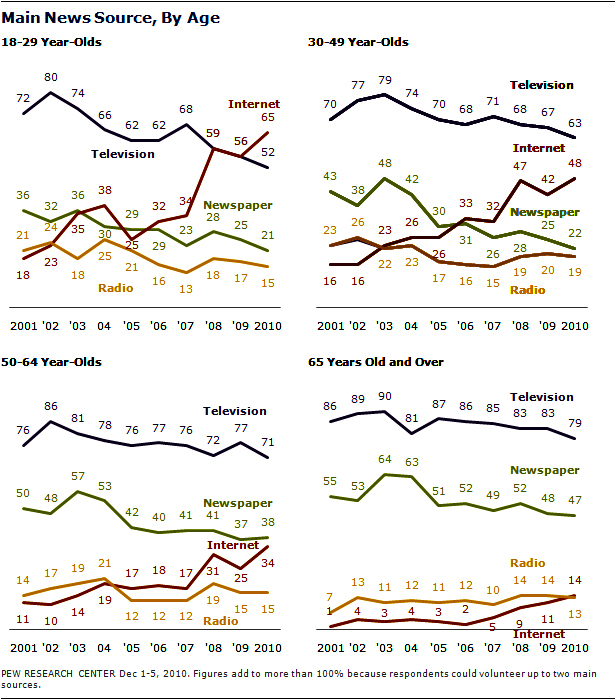
See Also:
- News-Journal Circulation Plummets 10% in First 6 Months Under New Ownership
- The Importance of Analytical Reporting
- The Suicide of Print Journalism
Charles Barkley Tells Why Tucker Carlson Is an Idiot
See Also:
- How Republicans Became America’s Arabs
- Idioting Up Over Islam, Rev. Franklin Graham Reveals America’s More Present Dangers

From Miller-McCune: “More than 60 years in the making and still incomplete, the South Dakota mountain that is being continually transformed into the Crazy Horse Memorial sculpture lies only a few miles from the shadow of Mount Rushmore. When complete, this provocative granite tribute to the larger-than-life, late 19th century Sioux warrior will be the largest sculpture in the world — a three-dimensional, mountain-sized homage 563 feet high and 641 feet long. The sculpture’s face, head and hair alone could hold the granite faces of all four presidents from the nearby Mount Rushmore National Memorial. […] Here in the Sioux’s sacred Black Hills, critics say that the memorial project has become as much about the life of Korczak Ziolkowski, the self-taught Polish-American sculptor who began the project, than Crazy Horse himself. […] Today, critics of the project often cite the fact that the memorial’s gate and concession fees have made the project “big money,” although the foundation receives no government funding and is financed by private donations and admissions. For the 2009 fiscal year, the foundation reported assets around $50 million, with revenue of a little more than $9 million that year, $3.5 million of that from admissions. […] One can only surmise that Crazy Horse would agree with Red Cloud, the Lakota chief, who famously observed of the white interlopers: “They make many promises, more than I can remember. They never kept but one; they promised to take our land, and they took it.”” The full story.
See Also:
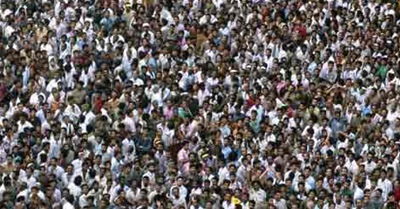 From National Geographic: “UN demographers consider the middle road their best estimate: They now project that the population may reach nine billion before 2050—in 2045. The eventual tally will depend on the choices individual couples make when they engage in that most intimate of human acts, the one Leeuwenhoek interrupted so carelessly for the sake of science. With the population still growing by about 80 million each year, it’s hard not to be alarmed. Right now on Earth, water tables are falling, soil is eroding, glaciers are melting, and fish stocks are vanishing. Close to a billion people go hungry each day. Decades from now, there will likely be two billion more mouths to feed, mostly in poor countries. There will be billions more people wanting and deserving to boost themselves out of poverty. If they follow the path blazed by wealthy countries—clearing forests, burning coal and oil, freely scattering fertilizers and pesticides—they too will be stepping hard on the planet’s natural resources. How exactly is this going to work? […] In the two centuries after Malthus declared that population couldn’t continue to soar, that’s exactly what it did. The process started in what we now call the developed countries, which were then still developing. The spread of New World crops like corn and the potato, along with the discovery of chemical fertilizers, helped banish starvation in Europe. Growing cities remained cesspools of disease at first, but from the mid-19th century on, sewers began to channel human waste away from drinking water, which was then filtered and chlorinated; that dramatically reduced the spread of cholera and typhus. […] The bad news is that 2030 is two decades away and that the largest generation of adolescents in history will then be entering their childbearing years. Even if each of those women has only two children, population will coast upward under its own momentum for another quarter century. Is a train wreck in the offing, or will people then be able to live humanely and in a way that doesn’t destroy their environment? One thing is certain: Close to one in six of them will live in India.” The full story.
From National Geographic: “UN demographers consider the middle road their best estimate: They now project that the population may reach nine billion before 2050—in 2045. The eventual tally will depend on the choices individual couples make when they engage in that most intimate of human acts, the one Leeuwenhoek interrupted so carelessly for the sake of science. With the population still growing by about 80 million each year, it’s hard not to be alarmed. Right now on Earth, water tables are falling, soil is eroding, glaciers are melting, and fish stocks are vanishing. Close to a billion people go hungry each day. Decades from now, there will likely be two billion more mouths to feed, mostly in poor countries. There will be billions more people wanting and deserving to boost themselves out of poverty. If they follow the path blazed by wealthy countries—clearing forests, burning coal and oil, freely scattering fertilizers and pesticides—they too will be stepping hard on the planet’s natural resources. How exactly is this going to work? […] In the two centuries after Malthus declared that population couldn’t continue to soar, that’s exactly what it did. The process started in what we now call the developed countries, which were then still developing. The spread of New World crops like corn and the potato, along with the discovery of chemical fertilizers, helped banish starvation in Europe. Growing cities remained cesspools of disease at first, but from the mid-19th century on, sewers began to channel human waste away from drinking water, which was then filtered and chlorinated; that dramatically reduced the spread of cholera and typhus. […] The bad news is that 2030 is two decades away and that the largest generation of adolescents in history will then be entering their childbearing years. Even if each of those women has only two children, population will coast upward under its own momentum for another quarter century. Is a train wreck in the offing, or will people then be able to live humanely and in a way that doesn’t destroy their environment? One thing is certain: Close to one in six of them will live in India.” The full story.
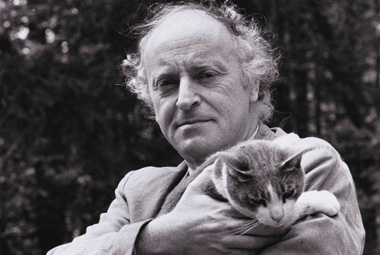
From Tablet: “With most writers, the passage of time helps to consolidate their achievement and fix their reputation. Fifteen years after a poet’s death would seem like ample time for this posthumous process to be completed—especially in the case of a poet as famous as Joseph Brodsky, who became internationally known in his twenties and won the Nobel Prize in 1987. Certainly there is no mystery about the standing of poets like Seamus Heaney or Derek Walcott, Brodsky’s friends, contemporaries, and fellow-laureates. Whether you enjoy reading Heaney or not, the shape of his achievement is clear; his name stands for a certain kind of writing and thinking. Brodsky, however, continues to look a little blurry to American readers. His work does not have the currency or influence, among younger poets, that his reputation would suggest. Some critics, especially in England, are prepared to dismiss him entirely, to call his work overrated and his reputation unearned. But most simply ignore him, as though he did not belong to the same conversation that includes Heaney or John Ashbery or Adrienne Rich. In one crucial sense, of course, he does not. All those poets write in English; but Iosif Aleksandrovich Brodsky, born in Leningrad in 1940, was a Russian poet. This means that it is Russian readers, familiar with Brodksy’s language and literary tradition, who must decide his claims to greatness. And as Lev Loseff shows in Joseph Brodsky: A Literary Biography, his clarifying new book, the best Russian judges have been unanimous about Brodsky from the beginning. […] Akhmatova, then 72 years old, immediately accepted Brodsky as an equal: “Iosif, you and I know every rhyme in the Russian language,” she told him. In 1965, after reading a poem of Brodsky’s, she wrote in her diary: “Either I know nothing at all or this is genius.” […] What makes Brodsky’s case so unusual is that this Russian poet spent almost half his life in America. […] But he never became a master of English, in the way that, say, Vladimir Nabokov did. (As Loseff points out, Brodsky came to English much later than Nabokov and was largely self-taught, while the well-born novelist had English tutors from childhood.) Indeed, Brodsky in English remains, all too often, wrenched, unidiomatic, and unmusical.” The full review.
See Also:
This short film, “Two Men,” is inspired by Kafka’s extremely short story, “Passers-by,” which can be reproduced here in full, as translated by Willa and Edwin Muir:
When you go walking by night up a street and a man, visible a long way off–for the street mounts uphill and there is a full moon–comes running toward you, well, you don’t catch hold of him, not even if he is a feeble and ragged creature, not even if someone chases yelling at his heels, but you let him run on.
For it is night, and you can’t help it if the street goes uphill before yo in the moonlight, and besides, these two have maybe started that chase to amuse themselves, or perhaps they are both chasing a third, perhaps the first is an innocent man and the second wants to murder him and you would become an accessory, perhaps they don’t know anything about each other and are merely running seperately home to bed, perhaps they are night birds, perhaps the first man is armed.
And anyhow, haven’t you a right to be tired, haven’t you been drinking a lot of wine? You’re thankful that the second man is now long out of sight.
The film, from vimeo, is directed by Australian Dominic Allen “and shot in the Kimberly town of Fitzroy Crossing by Joel Betts, features a robust and dynamic cast of indigenous Australian non actors. […] Two Men Running, Allen’s short film has been screened in a swathe of international film festivals including New York, Prague, London, Melbourne and Sydney and in 2009 was a Dendy Australian Short Film of the Year finalist.”
- In U.S., 46% Favor, 40% Oppose Repealing Healthcare Law
- Bill Clinton Takes Back the White House
- Le Monde: a blueprint of a turnaround
- Top hat question 7: biology, media, gay





























Leave a Reply